Tone production
Tone Production
Terminology
A string vibrates at a rate we call its frequency - for example the open A string vibrates 110 times a second - 110Hz.
But in addition to this fundamental, the vibration contains a mix of the individual harmonics or overtones that we can find over the 12th, 7th, 5th (and more) frets. For a string vibrating at 100Hz, the harmonics are 200, 300, 400... Hz.
Because of the logarithmic way that frequencies work, the harmonic sequence is a set of consonant tones, each higher than the previous by an octave, then a fifth, a fourth, a third... becoming ever closer, like the notes on a bugle.
We can't hear the harmonics, but their total blend is what makes a guitar
- Strident & metallic (many harmonics)
- Mellow & sweet (few harmonics)
One way to change the harmonic content
- Plucking near the bridge (sul ponti) gives the string an angular, asymmetrical shape when it is released - this promotes lots of harmonics
- Plucking nearer the fingerboard (sul tasto) gives the string a gentle shape when it is released and this produces a smaller harmonic content
- Plucking right in the centre suppresses all the even harmonics, making the sound sweet and "hollow", like a clarinet
Another way to change the harmonic content is to change how the string is actually plucked - more later!
A picture's worth a thousand words
Here's a graphical representation (exaggerated for clarity) showing the fundamental & overtones for both a mellow and metallic sound.
The graphs show volume (upwards) against pitch (to the right)
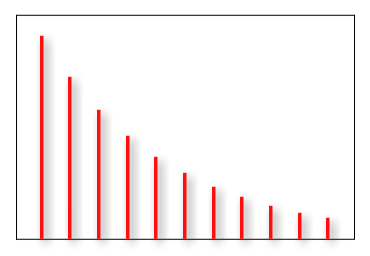 |
 |
| Metallic sound | Mellow sound |
Unlike orchestral instruments, a guitar is not a sustaining instrument - every note dies away. The higher harmonics tend to die away faster, but it's a well-known phenomenon that it's the start of a note - the "transient" - that defines the character of the note. A note with high harmonic content can seem more "punchy" - a stronger start and (apparently) a faster decay, as the harmonics die away. A rounded sound has a less imposing start but can seem more sustained, as it does not evolve much as it decays.
Tone and Timing
In an orchestra, every instrument except harp & percussion has a soft start. The guitar, by contrast, has a percussive start. We've seen that a metallic tone makes the sound even more percussive.
Now let's see how it is affected by the tightness of an ensemble's timing.
Let's look at two graphs
The graphs show volume (upwards) against time (to the right)
 |
 |
Metallic sound Most of the energy is dissipated quickly - the note doesn't carry |
Mellow sound The energy is released more evenly for a pleasing sound |
The metallic sound has a forceful beginning. It also has an unsatisfying "thinness" that permeates the whole sound. Because of the way the human ear reacts to different frequencies, a metallic sound can seem louder, but it is tiring to listen to in quantity.
Timing issues
Now see what happens if 3 players play the same note, but they are not quite "together"...
 |
 |
Metallic sound - 3 players playing not quite together Timing problems (like those here) really notice! |
Mellow sound - 3 players playing not quite together The total sound builds & decays pleasantly - the glitches don't notice |
Tone and Tuning
When two guitars are out of tune (or playing in unison, as the old joke goes), the two notes beat against each other.
If one player is playing a note at 200Hz and his partner's string vibrates at 200.5 Hz, there will be a beat note (the difference between the two fundamentals) of 0.5Hz - once every 2 seconds. In music of a moderate tempo, notes will be despatched much faster than this, and the tuning problem will not be heard.
However, if the two notes have a metallic sound (because they have a rich harmonic content) then the harmonics will beat against each other as well. The 800Hz harmonics, for example will beat twice a second, and this will be much more apparent.
Furthermore, metallic notes that are slightly out of tune have a "honky-tonk" sound that's even more apparent than the beating sensation.
In ensemble, in particular, a more rounded tone will not only conceal any beat notes, but kills off any tendency for the overall sound to have a honky-tonk quality that sounds so amateurish.
Tone and Texture
This is where things get more complicated and a little more controversial, and this page definitely skates round some of the real issues in a Niibori orchestra.
For example, we don't talk about thickening the bass line by doubling it an octave up, which deliberately adds extra harmonics.
Clarity
What makes for a glorious listening experience is when an ensemble has that clarity that lets you hear each and every line weaving amongst the others. How can we achieve that?
Take note
Many guitarists are familiar with the concept of spacing the notes in a chord so that the bass notes are more widely spread than the top.
Here are two chords - play them and hear how "close bass notes and spaced treble" notes sounds gruff and hollow, and how "spaced bass notes and close treble notes" sounds full and satisfying...
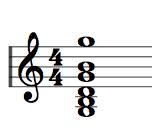 |
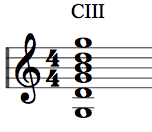 |
| A gruff chord | A clearer sounding chord |
Don't worry about the barré in the second example - here in the world of ensemble guitar, we share out the hard bits!
The soundscape
Here are the frequencies that make up the chords - high notes to the right. It's an exaggerated picture and I have emphasised the tune note a little.
 |
 |
| A gruff chord | A clearer sounding chord |
A metallic sound...
Because every note has harmonics, we need to add them into the picture as well. And here they are, added in.
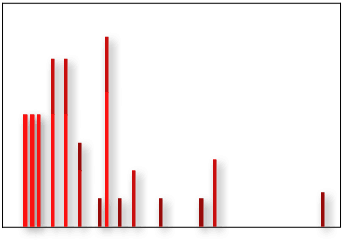 |
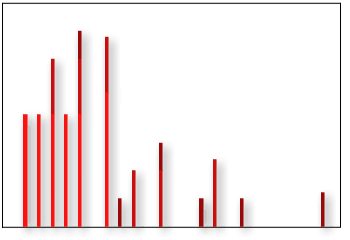 |
| A gruff chord with a metallic sound | A clearer sounding chord with a metallic sound |
You can see that what was a clean sound, easy on the ear, is gaining a complexity that makes it hard to pick out which are notes "inside" the chord and which is the tune note.
A mellow sound
Here's the same picture but with a rounded tone - so much easier to hear all the notes. In an ensemble, each note is a part, and so a rounded tone makes it easier to hear all the parts. It gives the orchestra clarity of sound.
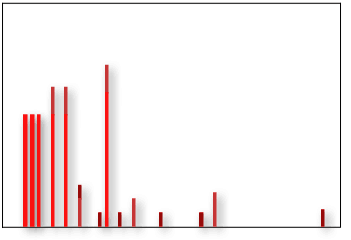 |
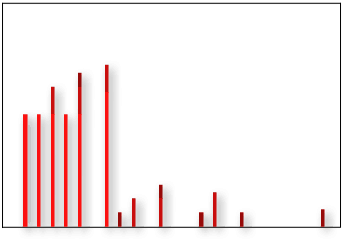 |
| A gruff chord with a mellow sound | A clearer sounding chord with a mellow sound |
Tone and Technique
Onto the final section in this little teach-in on tone production.
We have seen that playing away from the bridge will give a rounded tone, and that it is important not to seek volume at the expense of tone.
There are 2 more aspects of technique that will ensure a rounded tone.
Plucking Angle
The first applies particularly if you have slender fingers and nails, as opposed to broad fingers and nails. If the finger is applied to the string exactly at right angles (pointing towards your nose), then as the finger starts to pluck, the string will leave the tip and roll into the gap between tip and nail, giving a spurious click just as the string departs. This, coupled with the tiny plucking surface afforded by the tip of the nail, gives a high harmonic content to the sound.
- This is the metallic sound we're trying to avoid
By contrast, if the wrist follows the line of the forearm, the fingers will point towards the right shoulder. As the stroke is made, the string cannot roll into the gap between finger and nail, because the finger is angled. There is no click and the string is released by sliding from the nail, not by jumping over the tip of it.
Provided the nails are rounded and polished, the string will release cleanly and without trauma.
- This is the rounded sound we're trying to achieve
String Release
The second is to understand that the front of the guitar works by pumping air in and out of the guitar, and therefore the bridge moves in and out too.
That means that the direction of vibration of the string that couples most effectively to the bridge will be the one where the string vibrates (at least initially) towards and away from the soundhole.
When the string moves in this direction, the fundamental will be louder and the harmonics less so.
- This is the rounded sound we're trying to achieve
This can be achieved simply by pushing the strings into the soundhole as part of the plucking stroke, instead of just dragging them towards the next lower string. As the string is released, it has a large vertical component of vibration, making the sound rounded and considerably louder at the same time.
And so...
We've seen how a rounded tone is a real boon to any ensemble, concealing timing and tuning issues and promoting clarity and sustain.
Time to go and put all this into practice...
Download this teach-in
Download an e-book of all the teach-ins
Back to the FAQs contents